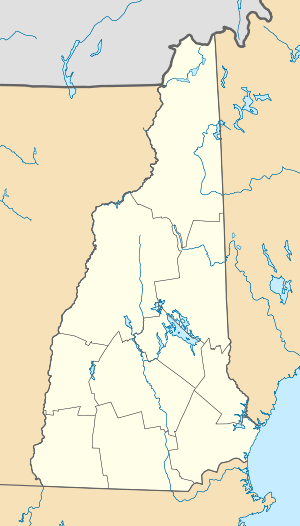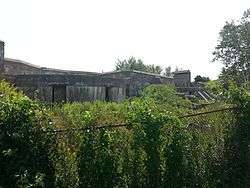Fort William and Mary
|
Fort Constitution | |
|
| |
  | |
| Location | New Castle, New Hampshire |
|---|---|
| Coordinates | 43°04′16.75″N 70°42′36.74″W / 43.0713194°N 70.7102056°WCoordinates: 43°04′16.75″N 70°42′36.74″W / 43.0713194°N 70.7102056°W |
| Built | Early 17th century |
| NRHP Reference # | 73000169[1] |
| Added to NRHP | July 09, 1973 |

Fort William and Mary was a colonial fortification in Britain's worldwide system of defenses, manned by soldiers of the Province of New Hampshire who reported directly to the royal governor. The fort, known locally as "the Castle", was situated on the island of New Castle, New Hampshire, at the mouth of the Piscataqua River estuary. It was captured by Patriot forces, recaptured, and later abandoned by the British in the Revolutionary War. The fort was renamed Fort Constitution in 1808.
Colonial period
First fortified by the British prior to 1632, the fort guarded access to the harbor at Portsmouth and served as the colony's main munitions depot. The fort also served to protect Kittery, Maine, on the opposite shore, which was raided numerous times by the tribes of the Wabanaki Confederacy during the French and Indian Wars.
American Revolution
In 1774, it was the only permanently manned military post in New Hampshire.
On December 14, 1774, local Patriots from the Portsmouth area, led by John Langdon, stormed the post and seized the garrison's powder, which was distributed through several New Hampshire towns for potential use in the looming struggle against Great Britain. On December 15, 1774, patriots led by John Sullivan again raided the fort, this time seizing numerous cannons.
1774 Raid

As tensions increased before the American Revolutionary War, Lord North's ministry became concerned that the profusion of arms in New England would lead to bloodshed. On October 19, 1774, King George III issued a confidential Order in Council forbidding the export of arms and powder to America.[2][3] Word of the order reached operatives in New England's patriot movement.
The port at Boston had been closed in punishment for the Boston Tea Party, and the Portsmouth Committee of Correspondence kept in close contact with friends of liberty in Boston. Tensions in Massachusetts nearly erupted into violence in the fall of 1774 when redcoats seized provincial gunpowder during the so-called Powder Alarm. Upon learning of the Order in Council, patriots feared that the British military would make another attempt to seize colonial stores. Patriots in Rhode Island moved munitions from the fort at Newport inland for safekeeping without incident. In Massachusetts, rumors flew that troops from Boston were headed to reinforce Fort William and Mary and seize its powder and arms. On December 13, 1774, four months before his more famous ride in Massachusetts, Paul Revere rode to Portsmouth to sound the alarm.
On the morning of December 14, Patriots from the town of New Castle unsuccessfully attempted to take the gunpowder at Fort William and Mary by trickery. Meanwhile, John Langdon made his way through Portsmouth with a drummer, collecting a crowd to descend on the fort. Several hundred men responded to his call, setting out for the Castle by way of the Piscataqua River. Only one provincial officer, Captain John Cochran, and five provincial soldiers were stationed at Fort William and Mary. Despite the odds against them, they refused to capitulate to Patriot demands. When Langdon's men rushed the fort, the defenders opened fire with three cannons and a volley of musket shot. Patriots stormed the walls and Cochran's men engaged in hand-to-hand fighting before being subdued by an overwhelming number of raiders. Langdon's volunteers not only broke open the powder house and absconded with about 100 barrels of gunpowder but, to three cheers, hauled down the fort's huge British flag. Several injuries but no deaths occurred in the engagement, and Cochran and his men were released after about an hour and a half of confinement.
The next day, additional rebel forces arrived in Portsmouth from across the colony, as well as from Maine. Led by John Sullivan, the rebels returned to the fort late on the night of December 15, overran the post without gunfire and removed muskets, military supplies and 16 cannons marked as the property of the King. British authorities declared the raids - for which Sullivan later received a stipend from the Continental Congress - high treason.
Aftermath
In response to a call for aid from Boston by British Governor John Wentworth, the armed hydrographic survey sloop Canceaux arrived to keep the peace in New Hampshire on December 17,[4] followed by the twenty-gun frigate Scarborough on December 19, with numerous Royal Marines aboard. The Governor and his family were driven from their home in Portsmouth in the summer of 1775 and forced to take refuge in the fort, guarded by the guns of British warships. Britain finally gave up on the colony of New Hampshire in order to focus attention on the military situation in Massachusetts and abandoned the fort, removing its remaining equipment to Boston along with Governor Wentworth.
The supplies captured by Patriots in December 1774 were later used by New Hampshire's forces against the British military, including in the Siege of Boston. Conversely, supplies (including numerous cannon) left in the fort by Patriots following the raids were subsequently put to use by the British forces.
Fort Constitution


The state gave Fort Point, on which Fort William and Mary stood, to the federal government in 1791. In 1800, the Portsmouth Naval Shipyard was established upriver on Fernald's Island (now part of Seavey's Island), and the fort was rebuilt under the Second System of US fortifications. Walls were doubled in height and new brick buildings added. Work was completed in 1808 and the defense renamed "Fort Constitution".[5] On July 4, 1809, an accidental explosion marred Independence Day celebrations at the fort, killing a number of soldiers and civilians. The Secretary of War's report on fortifications for December 1811 describes Fort Constitution as "an enclosed irregular work of masonry, mounting 36 heavy guns... (with) brick barracks for two companies..."[6] During the War of 1812 the fort was manned and expanded, Walbach Tower, a Martello tower with a single 32-pounder cannon, being built in 1814.[7]
During the Civil War, Fort Constitution was projected to be rebuilt as a three-tiered granite fortress under the Third System of US fortifications. However, advances in weaponry, particularly armored, steam-powered warships with heavy rifled guns, rendered the masonry design obsolete before it was finished. The fort's construction was abandoned in 1867 with the Second System fort largely intact and two walls from the Third System built around parts of it.[5]
In 1897 construction began on Battery Farnsworth, located under the hill on which Walbach Tower stands, as part of the large-scale Endicott Program of seacoast fortifications. It was part of the Coast Defenses of Portsmouth, along with Fort Stark and Fort Foster. The battery was completed in 1899. Named for Brigadier General Elon J. Farnsworth, the installation included two 8-inch (203 mm) M1888 guns on disappearing carriages.[8] The battery was accompanied in 1904 by Battery Hackleman, with two 3-inch (76 mm) M1903 guns on pedestal mounts. A mine casemate for an underwater minefield in the harbor was built; Battery Hackleman was built primarily to defend this minefield against minesweepers.[8]
After the American entry into World War I in early 1917, many guns were removed from coast defenses for potential service on the Western Front. Both 8-inch guns of Battery Farnsworth were removed for use as railway artillery in October 1917 and were not returned to the fort. In 1920 a mine casemate was built next to Battery Farnsworth to replace a similar facility at Fort Stark.[8]
In World War II Battery Hackleman's 3-inch guns were sent to a new battery of the same name at Fort H. G. Wright on Fisher's Island, New York. They were replaced by two 3-inch (76 mm) M1902 guns from Battery Hays at nearby Fort Stark. In 1940-1944 the Harbor Defenses of Portsmouth were garrisoned by the 22nd Coast Artillery Regiment. Also, a mine observation station was built atop Battery Farnsworth. Battery Hackleman was disarmed by 1948 and the fort was turned over to the Coast Guard. Battery Hackleman was demolished, but Battery Farnsworth can still be seen.[8]
Given back to the state in 1961, Fort Constitution State Park was listed on the National Register of Historic Places in 1973, and is today open to the public.
The lighthouse
Since 1771 the fort has been home to a lighthouse. The current installation, the Portsmouth Harbor Light, was completed in 1878. Its Fourth Order Fresnel lens remains a valuable aid to navigation. The tower and the grounds immediately around it are open for scheduled tours.
See also
- Seacoast defense in the United States
- United States Army Coast Artillery Corps
- 8th Coast Artillery (United States)
- National Register of Historic Places listings in Rockingham County, New Hampshire
References
- ↑ National Park Service (2007-01-23). "National Register Information System". National Register of Historic Places. National Park Service.
- ↑ Crout, Robert Rhodes, "Diplomacy of the American Revolution", in Encyclopedia of the American Revolution: Library of Military History. Ed. Harold E. Selesky. Vol. 1. Detroit: Charles Scribner's Sons, 2006. 318-321. U.S. History in Context.
- ↑ J. Franklin Jameson, "St. Eustatius in the American Revolution", The American Historical Review, Vol. 8, No. 4 (Jul., 1903), p.687
- ↑ Conforti, Joseph, Creating Portland: History and Place in Northern New England (2007) pp.55-58
- 1 2 Weaver, pp. 79-80
- ↑ Wade, p. 241
- ↑ Fort Constitution from American Forts Network
- 1 2 3 4 Fort Constitution at FortWiki.com
- Berhow, Mark A., Ed. (2015). American Seacoast Defenses, A Reference Guide, Third Edition. McLean, Virginia: CDSG Press. ISBN 978-0-9748167-3-9.
- Lewis, Emanuel Raymond (1979). Seacoast Fortifications of the United States. Annapolis: Leeward Publications. ISBN 978-0-929521-11-4.
- Wade, Arthur P. (2011). Artillerists and Engineers: The Beginnings of American Seacoast Fortifications, 1794-1815. CDSG Press. ISBN 978-0-9748167-2-2.
- Weaver II, John R. (2001). A Legacy in Brick and Stone: American Coastal Defense Forts of the Third System, 1816-1867. McLean, VA: Redoubt Press. ISBN 1-57510-069-X.
Further reading
| Wikimedia Commons has media related to Fort Constitution. |
- DeMitchell, Terri A. (2013). The Portsmouth Alarm: December 1774. Mahomet, IL: Mayhaven Publishing, Inc. ISBN 978-1932278927. (A fictionalized account of the raid on Fort William and Mary written for young adult audiences.)
- Elwin L. Page. "The King's Powder, 1774," New England Quarterly Vol. 18, No. 1 (Mar., 1945), pp. 83–92 in JSTOR
- Thomas F. Kehr, "The Seizure of his Majesty's Fort William and Mary at New Castle, New Hampshire, December 14–15, 1774," Essays and Articles, New Hampshire Society of the Sons of the American Revolution at
External links
- Detailed account of raids
- List of documented participants in raids
- Additional information at the University of New Hampshire
- Fort Constitution Historic Site (official website)
- Fort Constitution Historic Site (unofficial website)
- Fort Constitution from American Forts Network
- Concord Monitor Article; Sept. 20, 2005
- Portsmouth Harbor Lighthouse History
- List of all US coastal forts and batteries at the Coast Defense Study Group, Inc. website
- FortWiki, lists most CONUS and Canadian forts